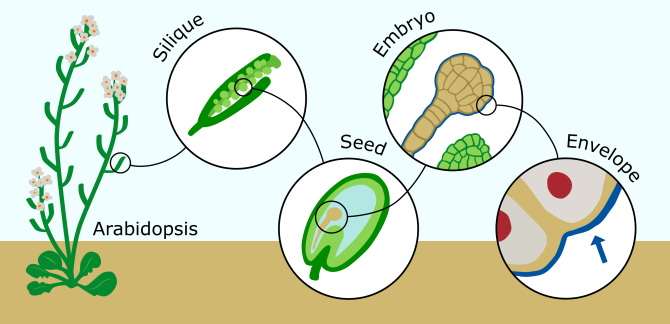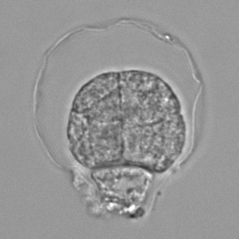Wageningen, The Netherlands
November 14, 2023
Wageningen researchers have discovered a previously unnoticed component within the thale cress: a thin film that encases the embryo in the seed. This discovery is particularly noteworthy because this species has been intensively studied for five decades. The newfound knowledge about the component could aid seed and breeding companies in maintaining the health of their seeds and plants.
Researchers from Dolf Weijers' biochemistry group and Joris Sprakel's mechanobiology group detailed their findings in the scientific journal Development. Although the exact role of this newly discovered component is not yet clear, scientists suspect that the embryonic envelope acts as a type of straitjacket, ensuring the embryo maintains the correct shape during its development.
 Illustration: Rikke Linssen
Illustration: Rikke Linssen
During the initial days after fertilization, the nutrient layer surrounding the embryo is not fully developed, allowing for more space. The membrane may play a crucial role in ensuring the embryo maintains its proper shape, preventing uncontrolled growth and bulging of cells, according to Weijers and Sprakel.
Invisible force
Despite its possible role to hold the baby plant in shape, the embryonic envelope is incredibly thin, which explains why plant researchers overlooked it for decades. Discoverers Yosapol Harnvanichvech and Cecilia Borassi stumbled upon the film accidentally while attempting to separate the sixteen cells of a young plant embryo. An invisible force was holding the cells together. It was only when the researchers looked under a microscope to understand why the cells were not detaching that they saw the film surrounding the embryo.
“Then we knew what to look for,” says Borassi enthusiastically. The plant scientists scanned detailed images of plant embryos that colleagues had taken years ago with an electron microscope. “It is typically one of those components that you only notice when you know it is there.” When the Wageningen researchers looked at scientific publications, they discovered similar membranes in photos of embryos in tobacco plants. Weijers and Sprakel are convinced that the same component occurs in many more, if not all, plants.
Factor in seed production
The implications of this discovery are significant for seed and breeding companies, as the membrane is thought to play a crucial role in seed and embryo health.“If you do not know that such an embryonic membrane exists, you cannot take it into account,” says Weijers. A damaged, deformed, or even missing membrane could have severe consequences for the growth and development of the baby plant.
To understand the exact consequences, scientists must manipulate or remove the embryonic envelope in the lab, but this proves challenging as the envelope consists of fats and proteins that are attached to each other via cross-links. This makes it completely elastic, extremely strong and difficult to break down with chemicals. “We have tried endlessly, but we still haven't succeeded,” says Harnvanichvech.
Gatekeeper as an alternative hypothesis
If fellow researchers succeed, we will gain clarity about the exact function of the membrane and the consequences of any mishaps. While the researchers suspect the previously mentioned straitjacket function is the most obvious role of the envelope, they do not rule out other possibilities. The envelope could act as a gatekeeper allowing only a select group of chemicals to pass through. “This way it may protect the young, vulnerable embryos against harmful substances,” says Borassi. Finally, the embryonic envelope could serve as an attachment point for the protective fat layer that the plant later develops. The fat layer may adhere better to the membrane than to the embryo itself
.

The membrane surrounding the plant embryo. Through a special treatment with enzymes, the embryonic envelope detaches from the embryo, making it clearly visible under a microscope.
Although more research is needed to reveal the role of the embryonic membrane, Harnvanichvech and Borassi are excited about their discovery. “It's really cool to discover something new with fundamental science,” Borassi said.
Wetenschappers ontdekken nieuw onderdeel in 's werelds best bestudeerde plant
Wageningse onderzoekers hebben een nieuw onderdeel ontdekt in de plant zandraket: een vliesje dat het embryo in het zaad omhult. Bijzonder, omdat plantwetenschappers deze specifieke plant een halve eeuw bestuderen zonder dit vliesje op te merken. Kennis over het nieuw ontdekte onderdeel helpt zaad- en veredelingsbedrijven mogelijk om hun zaden en planten gezond te houden.
Wetenschappers van de biochemiegroep van Dolf Weijers en de mechanobiologiegroep van Joris Sprakel publiceerden hun bevindingen in het wetenschappelijke tijdschrift Development. Wat de rol van het nieuw ontdekte onderdeel precies is, weten de onderzoekers nog niet. Ze vermoeden dat die zogenoemde embryonale envelop fungeert als een soort dwangbuis die het embryo in de juiste vorm houdt.
In het zaad wordt het embryo omgeven door een stevige voedingslaag die tegen het embryo drukt. Maar in de eerste dagen na bevruchting is die voeding nog niet rijp, waardoor het embryo meer ruimte heeft. “Dan zou het vliesje er weleens voor kunnen zorgen dat het embryo de juiste vorm behoudt, zodat de cellen niet ongelimiteerd groeien en gaan uitpuilen”, aldus de Weijers en Sprakel.
Onzichtbare kracht
Best indrukwekkend, want het vliesje zelf is extreem dun. Dat verklaart meteen waarom plantonderzoekers die embryonale envelop vijftig jaar lang over het hoofd zagen. Ook onderzoekers Yosapol Harnvanichvech en Cecilia Borassi, de ontdekkers van de embryonale envelop, hadden oorspronkelijk niet door waar ze mee te maken hadden. “Het was een toevallige ontdekking”, vertelt Harnvanichvech. Hij probeerde de zestien cellen van een plantenembryo van elkaar los te peuteren, maar ontdekte dat een onzichtbare kracht de cellen bijeen hield. Pas toen de onderzoekers onder een microscoop keken om te begrijpen waarom de cellen niet loslieten, zagen ze het vliesje rondom het embryo.
“Toen wisten we waar we naar moesten zoeken”, vertelt Borassi enthousiast. De plantwetenschappers scanden detailopnames van plantenembryo’s die collega’s jaren geleden met de electronenmicroscoop hadden genomen. “Het is typisch zo’n onderdeel dat je pas opmerkt wanneer je weet dat het er zit.” Toen de Wageningse onderzoekers wetenschappelijke publicaties bekeken, ontdekten ze op foto’s van embryo’s in tabaksplanten soortgelijke vliesjes. Weijers en Sprakel zijn ervan overtuigd dat datzelfde onderdeel in veel meer, zo niet alle planten, voorkomt.
Incalculeren in zaadproductie
Dat laatste is belangrijk voor zaad- en veredelingsbedrijven. Voor goede kwaliteit gewassen moeten de zaden gezond zijn en het embryo erin goed groeien. En de huidige hypothese stelt juist dat het vliesje daar een belangrijke rol in speelt. “Als je niet weet dat zo’n embryonaal vliesje bestaat, kun je er ook geen rekening mee houden”, aldus Weijers. Een beschadigde, misvormde of zelfs ontbrekend vliesje zou grote gevolgen kunnen hebben voor de groei en ontwikkeling van de babyplant.
Om te achterhalen wat die gevolgen precies zijn, moeten wetenschappers het vliesje in het lab manipuleren of verwijderen. Dat blijkt nog een flinke uitdaging. Het embryonale vliesje bestaat uit vetten en eiwitten die via dwarsverbindingen aan elkaar bevestigd zijn. Daardoor is het geheel elastisch, enorm sterk en moeilijk af te breken met chemicaliën. “We hebben het eindeloos geprobeerd, maar we zijn er nog steeds niet in geslaagd”, vertelt Harnvanichvech.
Poortwachter als alternatieve hypothese
Mochten collega-onderzoekers erin slagen, krijgen we duidelijkheid over de exacte functie van het vliesje en de gevolgen van foutjes of beschadigingen erin. Want hoewel een dwangbuisfunctie de meest voor de hand liggende rol is van het vliesje, sluiten de onderzoekers andere mogelijkheden niet uit. Zo zou het vliesje kunnen dienen als poortwachter die alleen een select groepje stofjes doorlaat. “Op die manier beschermt het wellicht de jonge, kwetsbare embryo’s tegen schadelijke stoffen”, zegt Borassi. Tot slot zou de embryonale envelop als aanhechtingsplaats kunnen dienen voor de beschermende vetlaag die de plant later ontwikkelt. Mogelijk hecht die vetlaag beter om het vliesje dan op het embryo zelf.
Hoewel er dus nog meer onderzoek nodig is om de rol van het embryonale vliesje te onthullen, zijn Harnvanichvech en Borassi opgetogen over hun ontdekking. “Het is ontzettend cool om iets nieuws te ontdekken met fundamentele wetenschap”, aldus Borassi.